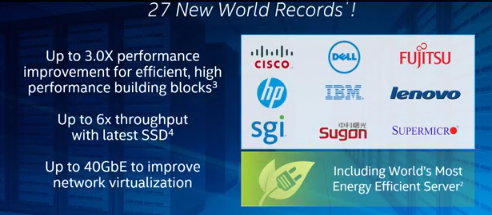Intel Wants To Reshape Datacenters With Xeon E5

Intel rolled out its "Haswell" generation of Xeon E5-2600 processors at its developers' forum by positioning the third version of the chip as the engine that would help in "re-architecting the datacenter" as a dynamic, automated, and software-defined environment where computing, storage, and networking are "pooled" to boost datacenter utilization.
The improvements in single-thread performance and overall system throughput for two-socket servers that dominate the datacenters are detailed here in this separate story at EnterpriseTech.
Meanwhile, Dianne Bryant, general manager of Intel's Data Center Group, also stressed during a webcast that up to 18 cores effectively triple Haswell's performance over the previous generations Xeon E5 processors. And the solid state disks that are used in conjunction with the new chips in the “Grantley” server platform brings a six-fold increase in system throughput with it a corresponding drop in latency, Bryant said.
The third-generation processor also marks the first use the latest industry standard memory, DDR4 SDRAM. Intel engineers have also allocated part of the cache to access main memory, providing what Bryant said was improved utilization of memory bandwidth.
One question that remained unanswered prior to the launch of the third-generation Xeon E5 processor was the number of customized SKUs commissioned by large customers. Bryant disclosed Monday that Intel is rolling out 32 custom platform solutions for specific workloads along with 20 customized SKUs of the chips.
The chip maker also said its partners has 65 Xeon E5-based server, storage, and networking systems ready to ship immediately.
Intel's vision for reshaping of the datacenter focuses primarily on scaling infrastructure on demand to keep pace with the rollout of new services and applications as the customer base expands. The other key ingredient for chipmakers is delivering maximum performance at the lowest possible total cost of operation. "So when you have scale, you need to have efficiency," Bryant stressed.
Intel also described Xeon partnerships with server makers, cloud providers, and telecommunications carriers that are steadily shifting their operations to software-defined infrastructure.
John Donovan, senior executive vice president for technology and network operations at AT&T, said during the Intel webcast the carrier is in the midst of "moving everything that we can possibly move into software-defined networking." Intel and AT&T have joint R&D programs aimed at leveraging Xeon for software-defined infrastructure, he added.
One outcome is what Donavan called a "user-defined network cloud" that provides AT&T's customers with the perceived ability to program the carrier's network.
Meanwhile, the chip giant also claimed that the new Xeon E5 helped double the performance of big data specialist Cloudera's distribution of Hadoop software used for storage and processing of large unstructured datasets.
The other part of the Intel's Xeon strategy is promoting the ability to run computing, storage, and networking workloads on a common architecture. From a deployment perspective, Bryant argued, "you have a simplified operating model with a common infrastructure management solution." Hence, Intel is pitching the Xeon E5 as providing a range of efficiencies that would ultimately help boost datacenter utilization.
Related
George Leopold has written about science and technology for more than 30 years, focusing on electronics and aerospace technology. He previously served as executive editor of Electronic Engineering Times. Leopold is the author of "Calculated Risk: The Supersonic Life and Times of Gus Grissom" (Purdue University Press, 2016).












